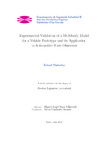Experimental validation of a multibody model for a vehicle prototype and its application to automotive state observers

Ver/
Use este enlace para citar
http://hdl.handle.net/2183/10097
A non ser que se indique outra cousa, a licenza do ítem descríbese como Reconocimiento-CompartirIgual 3.0 España
Coleccións
- Teses de doutoramento [2227]
Metadatos
Mostrar o rexistro completo do ítemTítulo
Experimental validation of a multibody model for a vehicle prototype and its application to automotive state observersAutor(es)
Director(es)
Naya Villaverde, Miguel ÁngelCuadrado Aranda, Javier
Data
2012Centro/Dpto/Entidade
Universidade da Coruña. Departamento de Enxeñaría Industrial IIResumo
[Abstract]
The simulation of multibody system dynamics is a key element of Computer-Aided Design and also a well-established tool in the development of new vehicles. A vehicle model is a typical multibody system made of rigid and/or flexible bodies that are interconnected by joints and usually undergo large translational and rotational displacements. In the last decade, real-time simulations of vehicle multibody models have gained interest thanks to the development hardware- or human-in-the-loop applications. Efficient multibody formulations must be employed to simulate complex systems in real-time and reliability of the models and validity are of the highest importance.
This thesis focuses first on the study of the validity of real¿time vehicle multibody models developed at the Laboratorio de Ingeniería Mecánica of the University of La Coruña. For this purpose, a vehicle prototype has been built and automated in order to repeat reference maneuvers. The numerous sensors on the prototype gather the most relevant magnitudes of the vehicle motion (roll-pitch-yaw rates, wheel speeds, etc). Two low speed maneuvers involving the longitudinal and lateral vehicle dynamics have been repeated several times in a test area at the campus of the engineering school. A real-time multibody model of the vehicle prototype has been prepared as well as a simulation environment that includes a close graphical environment, a true road profile and collision detection. Subsystems like brakes or tires have also been modeled. Both test maneuvers have been repeated with the developed multibody model in the simulation environment using inputs that have been measured experimentally. Selected simulation variables have then been compared to their experimental counterparts provided with a confidence interval that characterizes the field testing process errors. The results of the comparisons have then been interpreted to extract useful guidelines to build real-time vehicle multibody models.
Once a real-time vehicle model is validated, it not only raises the possibility to be used in hardware- or human-in-the-loop applications but also in on-board stability controllers. Nowadays simplified vehicle models coming from the classical vehicle dynamics theory are commonly employed in on-board stability controllers. The use of real-time vehicle multibody models in state observers (a widely-used control technique in stability controllers) is a research subject initiated a few years before the beginning of this thesis at the Laboratorio de Ingeniería Mecánica. The last part of this thesis goes first over the developed implementation of the Extended Kalman filter, a common state observer for nonlinear systems, with multibody models and, after that presents several new implementations using this filter and other filters coming from the family of the sigma-point Kalman filters.
Palabras chave
Vehículos
Prototipos
Prototipos
Dereitos
Reconocimiento-CompartirIgual 3.0 España






